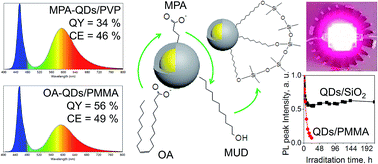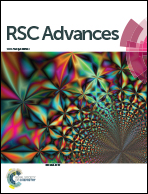Facile surface engineering of CuInS2/ZnS quantum dots for LED down-converters†
Abstract
We present a facile one-pot synthesis and simple surface modification strategies to prepare ternary CuInS2/ZnS quantum dots (CIS/ZnS QDs) functionalized with alkyl-, carboxyl- and hydroxyl-terminated ligands. Photoluminescence quantum yields (PLQY) up to 60% can be achieved for CIS/ZnS QDs synthesized on a gram scale. Aqueous mercaptopropionic acid (MPA) capped QDs are used as a base for further surface modification. On the one hand ligand–solvent interactions have been found to play a major role in the luminescence quenching mechanism of aqueous CIS/ZnS QDs. On the other hand, solvent extraction, immobilization in a polymer matrix or phase transfer greatly enhances the photoluminescence. Quantum yields in solution and in solid matrices differ greatly in the case of aqueous QDs both in polymers and in sol–gel silica. Surface engineered QDs are assessed for their usefulness in LED down-conversion experiments. We demonstrate that down-converter layer properties are not only dependent on the QD type and PLQY, but also on the matrix and the type of ligand shell. Despite significant (up to a factor of two) differences in PLQY between the hydrophobic and hydrophilic dots, their LED conversion efficiencies are comparable and up to 49% and 46% for hydrophobic and for hydrophilic QDs, respectively. Additionally, sol–gel nanocomposites incorporating CuInS2/ZnS QDs with OH-terminated ligands that can withstand 200 h high power blue LED irradiation are presented for the first time.



 Please wait while we load your content...
Please wait while we load your content...